Can A Hot Drink Make You Trust Someone More? Physical Warmth, Emotional Warmth and Trust
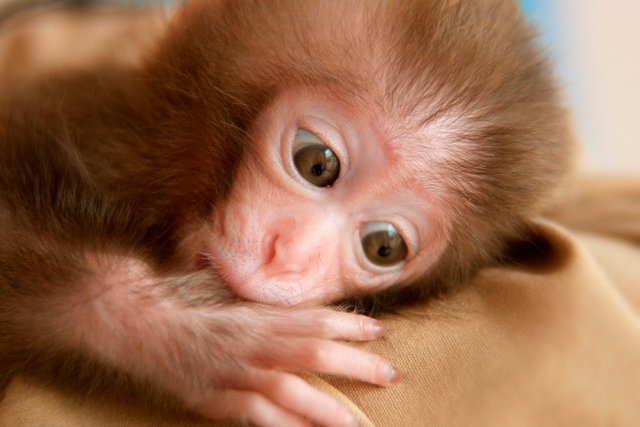
Introduction
Why is it that we refer to people we find agreeable as being warm and people that we find more hostile as being cold?
Are these mere metaphors or do they reflect an actual physical perception?
Further can physical warmth or cold affect our perception of others and even how much we trust them?
There is some interesting research in this field which can help to give us some answers.
I am arranging this post slightly differently and will start with the summary for those who want the TLDR version:
The Summary - TLDR version

There is growing evidence that both physical and emotional warmth are very closely related.
Priming people with a warm stimulus can result in greater feelings of warmth, social connection and altruism.
On the other hand priming people with a cold stimulus can increase negative feelings (e.g. lonliness, social exclusion) and induce people to judge others in a more negative or harsh light.
Cold stimuli may also make people less trusting of others, causing them to invest less in an economic trust game.
Recent fMRI research suggests that perceptions of both physical and emotional "warmth/coldness" are mediated by the same areas of the brain (insula and ventral striatum) and may be controlled by µ-opioid receptors.
This provides a mechanism by which these physical and more abstract perceptions are interrelated and interact.
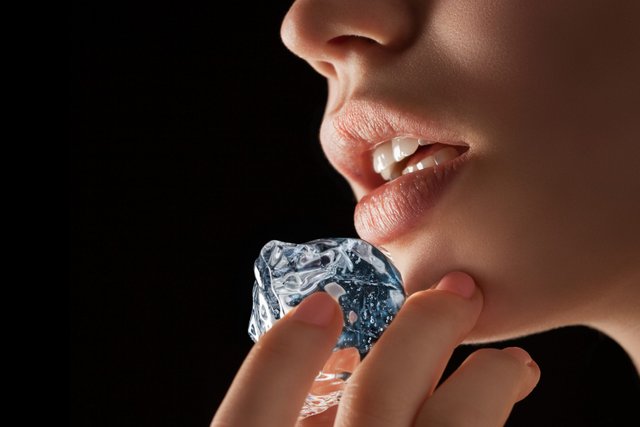
This body of research has implications for social interactions in general as well as possible effects in the justice system and in economics.
It also suggests that problems with social connectivity in certain mental illnesses could at least in part be treated using warm temperatures e.g. warm baths.
Unfortunately none of the research I was able to find tests "heat" treatments for illness directly although one study was suggestive of people using warm baths in this way to "self-medicate".
The involvement of µ-opioid receptors may also grant some insight into contributory factors to the rise in opioid abuse in some countries.
Is a lack of social connection in these countries at least in part causing people to seek a drug based substitute?
Further could application of heat be used to help treat this kind of addiction too?
Hopefully further research on this subject might provide more answers.
Read on for the more detailed discussion:
Early Work

In the 1940s Solomon Asch [1] demonstrated that one of the first impressions that people make of others is to classify them as being "warm" or "cold".
"Certain qualities are preponderantly assigned to the "warm" person, while the opposing qualities are equally prominent in the "cold" person."
Asch later hypothesised that "abstract psychological concepts are metaphorically based on concrete physical experiences".
He was one of the first people to make the connection between the metaphorical concept of warm/cold and the physical sensation of temperature.
In the 1950s and later Harlow [2] showed the importance of physical "sensory" contact with a soft "cloth" mother (versus a wire mesh mother) in order for infant monkeys to develop normally.
This work (though very cruel in my opinion) indirectly suggested at least a partial relationship between sensory physical input and the more abstract feelings of safety and comfort in monkey infants.
Although heat was not the primary focus of the study I think it is relevant that metal or wire feels colder to the touch (even at the same temperature).
Could this have been a further variable?
Priming With Physical Warmth Promotes Interpersonal Warmth
In a famous 2008 paper Williams and Bargh [3] demonstrated the relationship between physical and interpersonal warmth in a couple of interesting experiments.

First Experiment
Forty-one (mostly female) participants were invited to take part in a psychology experiment.
Unknown to them, part of the experiment involved them being primed on the way to the lab by an experimenter carrying either a hot coffee or an iced coffee.
During an elevator ride the experimenter would ask them to hold the coffee whilst they wrote something down.
For the experiment they were asked to read a description of a "target" person and then asked to rate them on 10 personality traits.
These were equally divided into warm/cold traits and unrelated (neutral) traits.
Those who had held the hot coffee in the elevator perceived the target person to be significantly "warmer" than those who held the iced coffee.
There was no difference in perception of neutral traits.
This suggests that exposure to warm or cold temperatures can affect our perception of people.

Second Experiment
In the follow up experiment they told participants that they were taking part in a product evaluation.
Fifty-three participants were given either a cold or a hot pack to evaluate (and hold).
Afterwards as their reward they were offered a choice of receiving a reward as a gift certificate for a friend or receiving it themselves.
Those exposed to the warm packs were more likely to choose the gift for a friend (54% vs 46% for self).
More interestingly, those exposed to the cold pack were much more likely to choose a gift for themselves (75% vs 25% for a friend).
This suggests that priming with temperature can influence people's kindness and willingness to give gifts.
It appears that colder temperatures promote more selfish behaviour and the magnitude of this effect is greater than the altruism produced by warm temperatures.
Heat and Loneliness

An interesting study by Bargh and Shalev [4] looked at whether there was an association with heat and loneliness.
They split their research up into several different experiments.
First Experiment: Loneliness and Baths
In the first they studied the association between feelings of chronic loneliness and taking baths in 51 participants.
They found that the higher people scored on scales of loneliness, the greater the frequency, duration and temperature of their bathing was.
This study was mainly done in a sample of students and the authors wanted to see if they could replicate the results in an older population.
In a repeat study in 51 older participants they found an association between temperature and duration of baths but not frequency.

Second Experiment: Hot/Cold Pack and Loneliness
In the second experiment they primed 75 participants with a hot or cold pack before getting them to fill in a loneliness rating scale.
A control group was also used who did not interact with the pack but did fill in the rating questionnaire.
Interestingly there was no significant difference in score between the controls and those who held the hot packs.
On the other hand, those who held the cold packs had significant increases in their ratings of loneliness.
This suggests that cold can increase feelings of loneliness and social isolation.

Third Experiment: Effect of Temperature on Need for Affiliation
For the first part of this experiment 176 participants were split in to 3 groups and asked to write about experiences of social inclusion, social exclusion or as a neutral control a recent meal they had.
The next stage was similar to the earlier experiment with the use of hot/cold packs but used a different scale to rate "need for affiliation" at the end.
This is basically a fancy name for how much people want to spend time with friends.
The main finding was that people in the social exclusion writing task, followed by the cold pack, expressed a significantly greater "need for affiliation" - i.e. they had a greater need to spend time with friends.
The use of the warm packs seemed to significantly diminish this effect.
So the suggestion is that physical warmth can reduce the need for affiliation - in a sense one could say that it is acting as a substitute for the emotional warmth one might receive from other people.

Fourth Experiment
There was a fourth experiment (using 60 participants) which I don't believe is so relevant to the discussion here but I will briefly mention it for the sake of completion.
The authors were testing how aware people are of a relationship between physical and social warmth and their results suggested that they are not.
It does appear then that people lack explicit awareness, or an accurate theory of the physical-social warmth relation."
Can Ambient Temperature Change How You Judge People?

In a fascinating experiment from 2013 Gockel et al. [5] studied how temperature might affect people's perceptions of criminals.
133 participants were divided into 3 groups with each group being assigned a room with a different ambient temperature:
- Low temperature (19.9°C).
- Mid temperature (23.8°C).
- High temperature (26.2°C).
They used previous data that suggested these temperatures fell into a perceived comfortable indoor temperature range so as to ensure that other variables such as discomfort were not affecting judgement.
Participants were then given a questionnaire to assess their affect (immediate mood/emotional state) to test their level of discomfort in association with the ambient temperature.
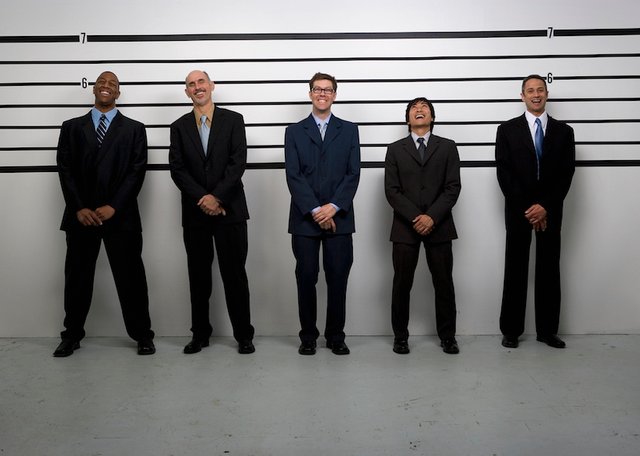
This was followed by the experimental task where they were shown photographs of criminals and asked to judge them in a variety of ways - e.g. what crime do you think they committed, was it premeditated etc.
The low temperature group were more likely to attribute crimes as being pre-meditated than the other groups.
Further they were more likely to assume they had committed more severe crimes, with a higher rate of murder attribution (9.6% vs 4.6%).
This study again suggested a greater response to cold conditions.
Further it raises some interesting questions about how ambient temperature my actually impact judgement of criminals within the legal system.
It would seem that a cold jury room or courtroom, might result in harsher judgements.
Temperature, Trust and Economic Behaviour

In the first part of a 2011 study Kang et al [8] tested temperature effects in an economic trust game on 30 students. Their results were interesting:
"As predicted, participants who touched cold packs later invested on the average of 20 less cents in each trial than those who had touched warm packs. None of the participants suspected an influence of temperature on their investments.
I also like that they looked at the following point in their statistical analysis:
"Cold packs were rated to be marginally less pleasant than warm packs with the average pleasantness ratings falling between neutral and mildly pleasant for cold, and mildly pleasant and pleasant for warm packs. However, pleasantness ratings did not predict invested money. Instead, temperature predicted invested money independent of the pleasantness that it aroused. Analysis of covariance revealed that invested money still significantly differed by temperature manipulation after adjusting for pleasantness scores."
This is important because we would want to eliminate (as far as it is possible) any effect that comfort or discomfort may have.
This experiment did not use a neutral temperature pack or control and I think that might have helped to distinguish more of the difference in effect between hot and cold.
Was it that cold put's people off investing or that heat makes them more likely to invest?
The second part of the experiment (see below) is suggestive of the former but it would be useful to test directly.
What is going on in the brain? fMRI Studies
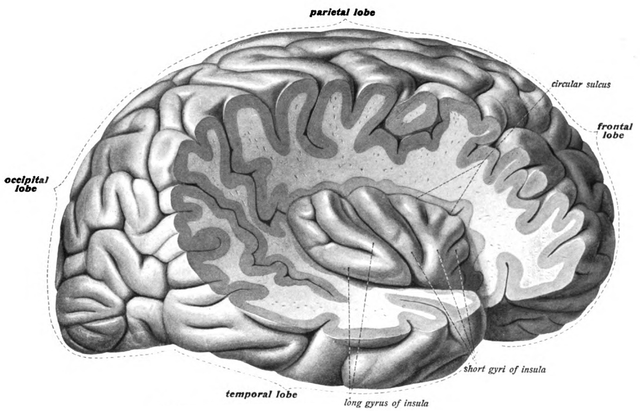
Source: PD via Wikipedia: Author Dr. Johannes Sobotta
There is growing evidence that both the physical feelings of warmth/cold and the emotional feelings/perceptions are dealt with by the same areas of the brain.
It seems one of our old neurological friends - the insula is involved in both [3,6,8].
In the second part of the previously mentioned study Kang et al [8] carried out fMRI analyses on participants in a trust game:
"Bilateral insular-opercular cortex showed greater association with cold temperature relative to neutral and warm temperatures. Of note, the left-anterior insular cortex was more active during trust decisions only after experience with cold but not warmth."
This would suggest the greater relevance of cold stimuli at least in relation to economic trust. Although this is not the same as social "warmth" I thought I should mention it as it is related.
You are more likely to trust someone if you feel emotional "warmth" towards them and the insular region is involved in both situations.
Returning to physical warmth/emotional warmth situation:
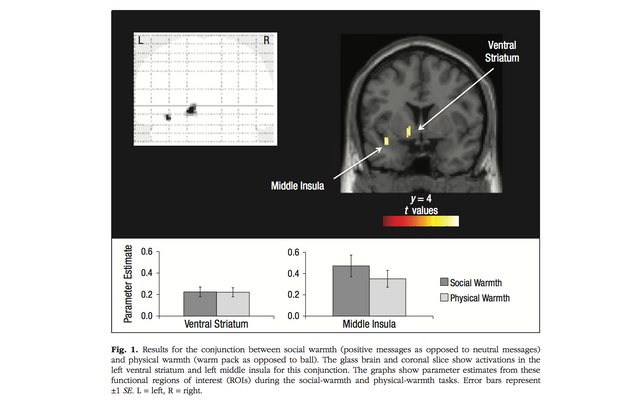
Inagaki and Eisenberger [6] carried out testing on 20 subjects exposed to socially warm cues and physical warmth whilst undergoing fMRI scanning.
First, neural activity during exposure to warm compared with neutral stimuli was examined across the whole brain. Replicating previous work on the brain’s response to warm stimuli, we found greater activity in the bilateral VS [ventral striatum], left middle insula, and left anterior insula when participants were holding the warm pack compared with when they were holding the ball. There was also increased activity in the right posterior insula as well as in the primary and secondary somatosensory cortices, which is consistent with results of studies that involve warm, cutaneous sensory stimuli.
Next, we assessed activity to reading positive, loving messages from friends and family members compared with neutral messages. As expected, participants displayed extensive activity in the VS, the anterior and middle insula, the pACC, and the ventral tegmental area to reading the positive messages (vs. neutral messages). There was also increased activity in several neural regions previously associated with mentalizing (dorsomedial prefrontal cortex, temporal pole, precuneus) as well as increased activity in septohypothalamic regions previously implicated in affiliative responding
They found shared activity in both situations:
The conjunction analysis revealed shared neural activity in the left VS, and left middle insula during the social and physical-warmth tasks, in which participants read positive (vs. neutral) messages and held the warm pack (vs. the ball), respectively.
The implication is that social warmth and physical warmth are governed by the same neural mechanisms.
The µ-Opioid Receptor

Towards the end of their paper Inagaki and Eisenberger [6] make an interesting point.
Both the insula and VS are rich in µ-opioid receptors. These are the same receptors that are stimulated by many drugs of abuse (particularly opiate painkillers).
These receptors can change both the perception of temperature/warmth as well as the actual body temperature.
In a later follow up study [7] the same authors found that administration of an opioid blocking agent (naltrexone) to 31 participants reduced the warm "social" feelings induced by holding a physically warm object.
This would back up their theory. It also raises an interesting question.
Right now many western countries are experiencing a huge surge in opioid addiction.
Are people using opioids to replicate the sensation of social connection? Further could physical warmth be used to help treat such problems?
Problems and Conclusions

This is just a brief review of some of the evidence I was able to find in relation to the connection between emotional and physical warmth.
This research definitely suggests a priming effect of physical warmth on both emotional warmth towards and the perception of others.
As is often the case with psychological studies there are some methodological limitations.
Unfortunately in order to keep this brief I can't cover each study in detail but the usual caveats relating to sample size and interpretation of results apply.
It is also very hard to remove all confounding variables and potential placebo effects.
Please read the studies for yourself if you are interested in the subject as that should give you a better idea.
Further I have only looked at the more recent studies that are open-access and available online.
Searching on Pubmed does suggest a consistency of results which is not conclusive in and of itself but does provide some weight to these theories.
As always we will need more research.
References
Asch, S. E. 1946. “Forming Impressions of Personality.” Journal of Abnormal Psychology 41 (July): 258–90.
Harlow, H. F. 1958. “The Nature of Love.” The American Psychologist 13: 673–85.
Williams, Lawrence E., and John A. Bargh. 2008. “Experiencing Physical Warmth Promotes Interpersonal Warmth.” Science 322 (5901): 606–7.
Bargh, John A., and Idit Shalev. 2012. “The Substitutability of Physical and Social Warmth in Daily Life.” Emotion 12 (1): 154–62.
Gockel, Christine, Peter M. Kolb, and Lioba Werth. 2014. “Murder or Not? Cold Temperature Makes Criminals Appear to Be Cold-Blooded and Warm Temperature to Be Hot-Headed.” PloS One 9 (4): e96231.
Inagaki, Tristen K., and Naomi I. Eisenberger. 2013. “Shared Neural Mechanisms Underlying Social Warmth and Physical Warmth.” Psychological Science 24 (11): 2272–80.
Inagaki, Tristen K., Michael R. Irwin, and Naomi I. Eisenberger. 2015. “Blocking Opioids Attenuates Physical Warmth-Induced Feelings of Social Connection.” Emotion 15 (4): 494–500.
Kang, Yoona, Lawrence E. Williams, Margaret S. Clark, Jeremy R. Gray, and John A. Bargh. 2011. “Physical Temperature Effects on Trust Behavior: The Role of Insula.” Social Cognitive and Affective Neuroscience 6 (4): 507–15.
Thank you for reading
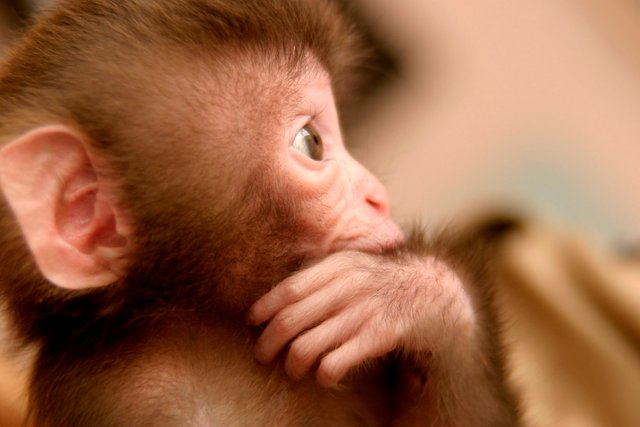
Before you go have you filled in the Coinbase form to list STEEM? It only takes a few seconds. THIS POST shows you how.
If you like my work please follow me and check out my blog - @thecryptofiend
Uncredited Images are taken from my personal Thinkstock Photography account. More information can be provided on request.

The brain is not a storage cabinet, it,s a transmitting and receiving device. That´s what I believe. Nice post! Upvote
Thanks:)
Hot...hot...hot! (; Very good ! (;
Thanks!
Very fascinating.. happy to live in the warmth of the tropics ;-)
Thanks - you are lucky:)
We all create our own happiness and freedom! Lived in cold and gray Belgium for 31 years and decided to move to a warmer tropical climate 2.5 years ago... the warmth surely does something to your mood, energy, friendliness, emotions, and so much more... Absolutely loving it... Always welcome here to come and soak up some loving and healing warmth ;-)
Thanks:)
I really like this post and it really makes you think. I am going to start following you.
Thanks:)
This is a very interesting post. Fascinating indeed.
Thank you:)
wow, amazing..
i love your post
Thank you:)
@thecryptofiend I freaking like your post...
all I know is that though you live in a very cold place you are one of the warmest Steemian's I've ever made friends with virtually that though I have never met you in person somehow I trust you for the kindness and the support that you have consistently shown us. The rest may never know how many unnoticed posts you actually tweet out there even in the wee hours of dawn.
Many people say Asians are very warm and I wonder if its true that it's because of the weather there back then .. however, when I came here though it's cold we've still stayed warm so I suppose it's also what our folks and the pips in our environment have modeled us. Where I live is very cold but most of the Dutch are very warm so are our neighbors the Germans and the Belgians .. or at least .. those I met . I suppose ...every where in the world there's that warm and cold person who we may perceive as "warm" but perhaps others may perceive as "cold".
Thanks you are too kind. You know I hadn't considered whether warm climates may figure in this. I think too much heat - ie that is uncomfortable causes the opposite effect most likely due to discomfort but it is likely there is a kind optimum climate.
@thecryptofiend no am not too kind, I can be cold, too - I tend to mirror how another person treats me .. some say its the cold but too much heat does get someone irritable at some point, too . As for holding something warm or cold on my hand .. I'd better be careful with how I out my perception on someone when in this situation then... having read your article :D
you are welcome
VERY good presentation. Excellent analysis.
One thing that comes to mind is how the actual molecular nature of hot/cold is just the distance of molecules.
Really cool. Good work.
Upvoted!
@shayne
Thanks yes that is a metaphor in itself for being close or not to other people!
Although it's reversed in physics: the closer together, the colder; the further, the warmer. Interesting.
Yes I hadn't thought of that!
I Just UpVoted You! Please See Our Very Important Post Below Regarding The Blockchain Witnesses. Have An Epic Day/Afternoon/Evening!
https://steemit.com/witness/@iloveupvotes/witness-guide-suggestions-and-witness-warnings